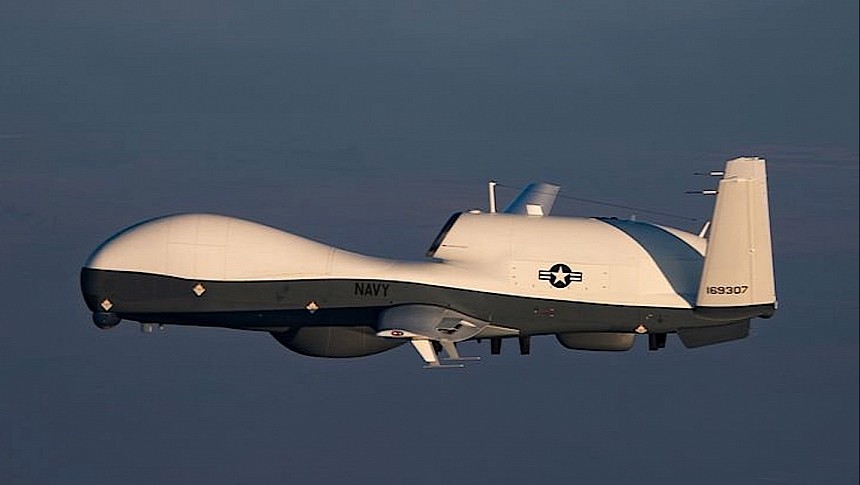Like all of America's military branches, the U.S. Navy has a series of intelligence, surveillance, and reconnaissance (ISR) assets in operation, but only one is high-altitude, long-endurance, and also offers targeting capabilities: the MQ-4C Triton. And the platform is as of last week fit for duty.
The Triton is a product of Northrop Grumman, and it has been tested with the American Navy for a while now. Five such drones have been deployed in recent months with the Navy's Pacific Fleet for maritime ISR, being put through their paces to see if they can fulfill sailors’ demands.
The drone made its first flight about a decade ago, but it wasn't until May 2020 that it got early operational capability for Navy use. It took another two years or so for it to receive initial operating capability (IOC), a milestone announced last week by Northrop Grumman.
IOC means that a military asset can now be used at least in the minimum deployable form. For the Triton, that translates into a flight time of 24 hours and a maximum altitude of ten miles (16 km).
“Triton has proven to be invaluable for the maritime patrol and reconnaissance mission in the Indo-Pacific. Now that the system has achieved initial operating capability, commanders will be able to fully leverage Triton’s powerful sensor suite to detect and deter potential adversaries around the world,” said in a statement Rho Cauley Bruner, Northrop Grumman Triton program director.
The single Rolls-Royce turbofan engine it is fitted with allows it to travel at speeds of up to 357 mph (575 kph). While doing so, it spies on things below, and can even lock targets, with the help of a myriad of sensors and cameras that give it a 360-degree field of view.
The drone can be sent on a mission either alone or in conjunction with crewed aircraft. The maximum distance it can reach is 9,400 miles (15,000 km), which is roughly the distance that separates New York from Sidney.
All of the above means that in a single 24-hour mission this mighty drone can look at a total of 4.6 million miles (7.4 million km) of sea and land – that’s about as much as the entire surface area of the United States in square miles.
The many uses envisioned for the Triton, which was derived from the Global Hawk, includes anything from patrolling the seas to search and rescue and comms relay. It can also be used to spot and track maritime targets from well outside the enemy ships’ reach.
The MQ-4C Triton is being put together by Northrop Grumman for both the U.S. Navy and the Royal Australian Air Force (RAAF). The production run planned for the drone’s initial years on the market is capped at about 70 units. The cost of a single such drone is estimated at $180 million.
The drone made its first flight about a decade ago, but it wasn't until May 2020 that it got early operational capability for Navy use. It took another two years or so for it to receive initial operating capability (IOC), a milestone announced last week by Northrop Grumman.
IOC means that a military asset can now be used at least in the minimum deployable form. For the Triton, that translates into a flight time of 24 hours and a maximum altitude of ten miles (16 km).
“Triton has proven to be invaluable for the maritime patrol and reconnaissance mission in the Indo-Pacific. Now that the system has achieved initial operating capability, commanders will be able to fully leverage Triton’s powerful sensor suite to detect and deter potential adversaries around the world,” said in a statement Rho Cauley Bruner, Northrop Grumman Triton program director.
The single Rolls-Royce turbofan engine it is fitted with allows it to travel at speeds of up to 357 mph (575 kph). While doing so, it spies on things below, and can even lock targets, with the help of a myriad of sensors and cameras that give it a 360-degree field of view.
The drone can be sent on a mission either alone or in conjunction with crewed aircraft. The maximum distance it can reach is 9,400 miles (15,000 km), which is roughly the distance that separates New York from Sidney.
All of the above means that in a single 24-hour mission this mighty drone can look at a total of 4.6 million miles (7.4 million km) of sea and land – that’s about as much as the entire surface area of the United States in square miles.
The many uses envisioned for the Triton, which was derived from the Global Hawk, includes anything from patrolling the seas to search and rescue and comms relay. It can also be used to spot and track maritime targets from well outside the enemy ships’ reach.
The MQ-4C Triton is being put together by Northrop Grumman for both the U.S. Navy and the Royal Australian Air Force (RAAF). The production run planned for the drone’s initial years on the market is capped at about 70 units. The cost of a single such drone is estimated at $180 million.








